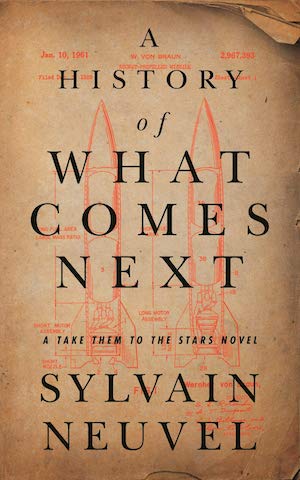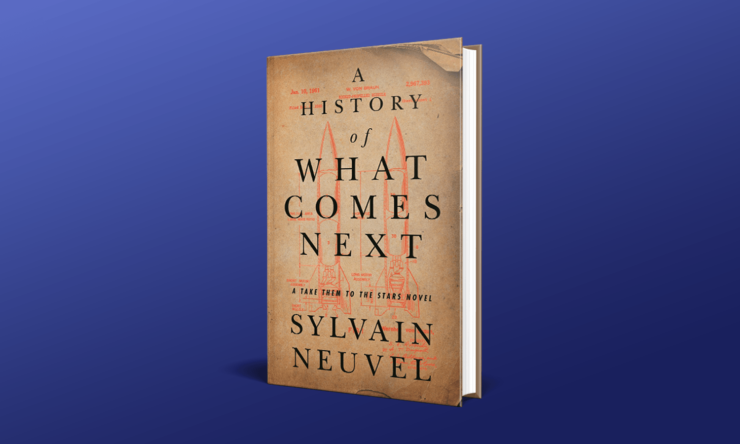What makes for a good shadow history? There’s a fine line between this and an alternate history, after all—in the latter, historical events themselves are altered, while in the former, the events take place as-is but the motivations behind them are different. A History of What Comes Next is Sylvain Neuvel’s own take on the sub-genre; that its subtitle is “A Take Them to the Stars Novel” suggests that more are on their way. Based on this introduction to the premise and setting, Neuvel is off to a good start, with a compelling setup during a fascinating moment in history—and plenty of questions to answer along the way.
After a prologue that establishes one of the concepts at the heart of the novel—a family comprised of mothers and daughters, with only two generations alive at any given time, and secrets worth killing over—Neuvel takes the reader to Germany in 1945, where a young woman named Mia is working for the OSS and carrying out secret missions on behalf of her mother Sarah. Mia’s voice, brash and defiant, is immediately captivating; of the OSS, she notes that “these people will recruit just about anyone,” citing baseball catcher-turned-spy Moe Berg as an example.
Mia’s work involves pretending to be the niece of German rocket scientist Wernher von Braun and, eventually, helping von Braun and a number of his colleagues to the United States. The mother-daughter pairs in the novel are known as the Kibsu, and over the course of the novel Neuvel reveals more and more about their history via interludes showing the lives of some of their ancestors across bygone centuries.
Buy the Book


A History of What Comes Next
The Kibsu have a goal: they are, for all intents and purposes, playing both sides in the then-nascent Cold War against one another to spark a race for space exploration. The Kibsu have an adversary as well—a mysterious figure known as the Tracker hunting them, about which more is revealed over the course of the novel. The presence of the Tracker adds to the rootlessness of both mother and daughter, as they fear the Tracker may draw too close and further upsets their sense of stability.
The vast majority of A History of What Comes Next is told from the perspectives of Sarah and Mia, and the first person/present tense approach makes for a genuinely gripping read during the novel’s many daring escapes, chase sequences, and fights for dear life. The tradeoff comes via some other elements being relegated to the background. Sarah often speaks about her work influencing the American and Soviet space programs, but there’s little firsthand sense of how she’s pulling this off. Maybe Neuvel plans to get into this in later books of this series, or maybe it’s intended to be somewhat mysterious, but I found myself curious about how Sarah was pulling all of this off.
The immediacy of the narration also bolsters the worldbuilding Neuvel carries out here. For all that Mia and Sarah (primarily Sarah, as Mia frequently rebels against her mother’s plans) have their own agenda and the knowledge that there’s something about them that sets them apart from the rest of humanity, they also don’t have all the answers, due to an occurrence that took place dozens of generations earlier. (I was reminded, structurally, of Kieron Gillen and Jamie McKelvie’s The Wicked + The Divine more than once while reading it, though the two books are very different in other ways.) Why have the Kibsu engaged in such a long game, and what’s the truth of their origins? By the end of A History of What Comes Next, the reader will have some answers—though Neuvel has clearly saved some revelations for later volumes.
In short, this is a secret history of the origins of the space programs in the USA and USSR, abounding with spies, conspiracies, and shifting allegiances. It manages to feel reasonably complete while simultaneously setting up the framework for larger stories—neither of which is a small accomplishment. And Neuvel concludes the novel with a section discussing the real-life history he drew on to write this novel, including the life of Chinese rocket scientist Qian Xuesen, who is also one of the novel’s recurring characters. It’s a fascinating perspective on where this particular shadow history is coming from—and how real life can sometimes be as compelling as science fiction.
A History of What Comes Next is available from Tordotcom Publishing.
 Tobias Carroll is the managing editor of Vol.1 Brooklyn. He is the author of the short story collection Transitory (Civil Coping Mechanisms) and the novel Reel (Rare Bird Books).
Tobias Carroll is the managing editor of Vol.1 Brooklyn. He is the author of the short story collection Transitory (Civil Coping Mechanisms) and the novel Reel (Rare Bird Books).










